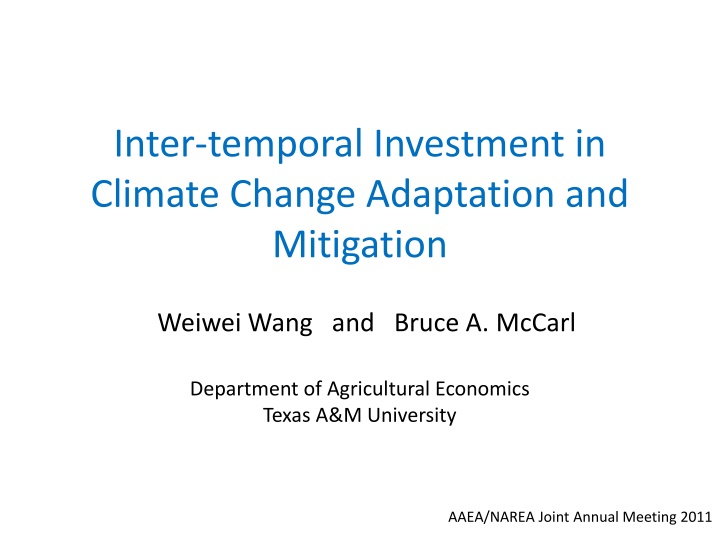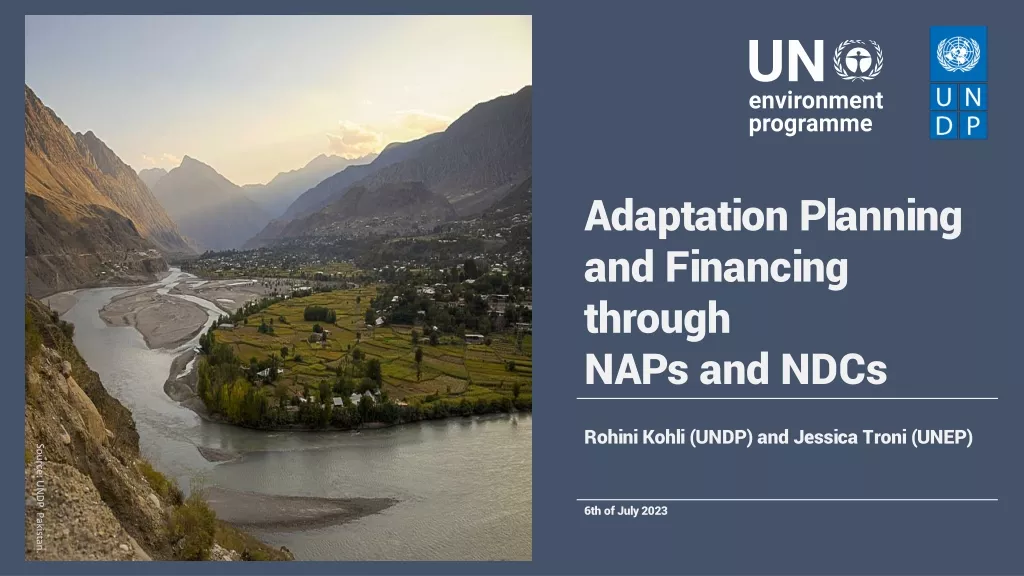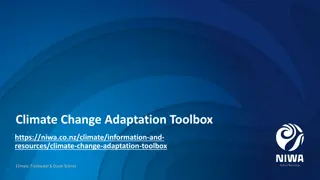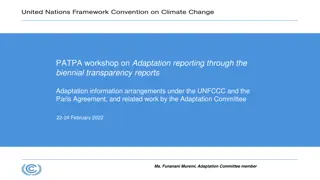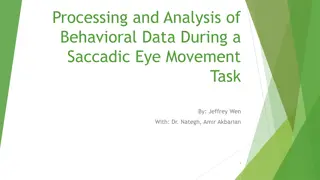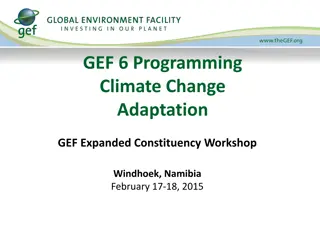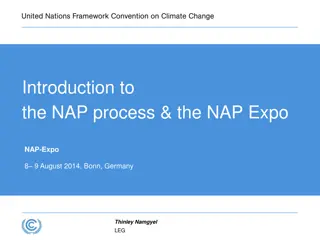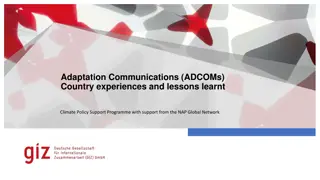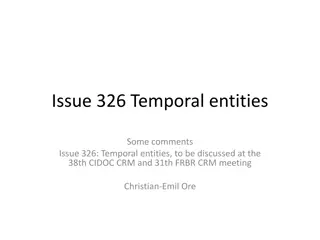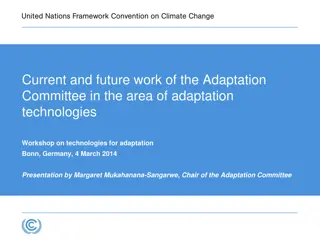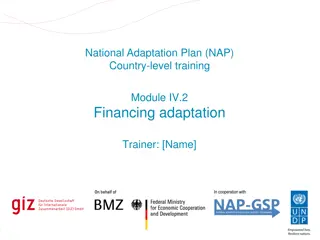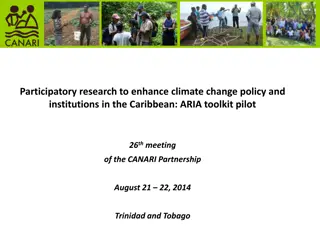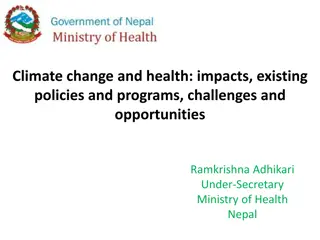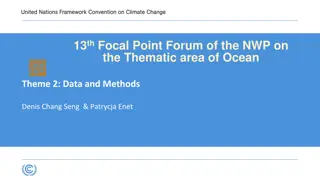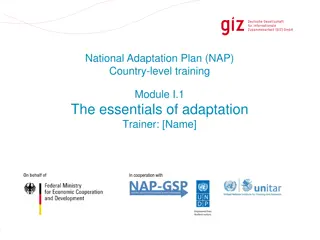Inter-temporal Investment in Climate Change Adaptation
This research focuses on optimal investment strategies for climate change adaptation and mitigation over time, exploring the relative contributions and social optimal allocations of adaptation and mitigation efforts. It delves into the economic considerations and policy directions for addressing climate change, aiming to understand effective and cost-efficient mainstreaming of climate policies using static optimal control models.
Download Presentation

Please find below an Image/Link to download the presentation.
The content on the website is provided AS IS for your information and personal use only. It may not be sold, licensed, or shared on other websites without obtaining consent from the author.If you encounter any issues during the download, it is possible that the publisher has removed the file from their server.
You are allowed to download the files provided on this website for personal or commercial use, subject to the condition that they are used lawfully. All files are the property of their respective owners.
The content on the website is provided AS IS for your information and personal use only. It may not be sold, licensed, or shared on other websites without obtaining consent from the author.
E N D
Presentation Transcript
Inter-temporal Investment in Climate Change Adaptation and Mitigation Weiwei Wang and Bruce A. McCarl Department of Agricultural Economics Texas A&M University AAEA/NAREA Joint Annual Meeting 2011
Outline Introduction Climate change Political strategies Conceptual Framework Optimal control model with both adaptation and mitigation investment Technical Part Adding explicit adaptation to DICE model Sensitivity analysis Conclusion Future Work
Climate Change IPCC (2007) Most of the observed increase in global average temperatures since the mid-20th century is very likely (>90%) due to the observed increase in anthropogenic (human emission caused) greenhouse gas concentrations. Climate change is a unique externality. The future will depend on the choices we make about Do little and live with it Mitigate Emissions Plan to adapt ?
Policy Directions Economic Considerations Effective climate policy involves a portfolio of adaptation and mitigation Source IPCC Fouth Assessment Report WGII Ch 18
Research Objectives What are the relative contributions of adaptation and mitigation to climate change damage reduction? What are the social optimal allocations of investment in adaptation and mitigation over time? How mainstreaming climate policy would be most effective and cost-efficient?
Static Optimal Control Model Adaptation + Mitigation ) , ( a c q TCDA = + + Min m, ( ) ( ) IM m IA a a = . . t s ( ) c g m where TCDA: total climate change damages with adaptation c: realized climate change m: mitigation effort a : the level of adaptation effort IM: mitigation investment q(c,a): losses of realized climate change IA: adaptation investment and the degree of adaptation effort IA(a): the cost of investment in adaptation Figure 1. Optimal adaptation and mitigation investment. Panel (a) shows optimal investment in mitigation in the absence of adaptation; Panel (b) the corresponding optimal adaptation investment at the optimal level of mitigation; Panel (c) optimal mitigation investment when alternative adaptation efforts are introduced
Literature Review on modeling adaptation and mitigation DICE (Dynamic Integrated Model of Climate Change Economics) (Nordhaus et al, 1992) Mitigation investment competes with consumption and non-climate investment Assumes optimal reactive adaptation wherever possible but largely ignores proactive adaptation activities and costs AD-DICE (Adaptation in Dynamic Integrated model of Climate Change Economics) (de Bruin et al, 2009) Adaptation is a powerful option in the first 100 years while mitigation does so afterwards adaptation costs are instantaneous rather than persistent and based on coastal protection
Literature Review Contd.. FEEM-RICE (Bosello, 2008) Planned adaptation and mitigation are strategic complements Calibration of adaptation costs was based on 1990 s surveys AD-WITCH (Adaptation- World Induced Technical Change Hybrid) (Bosello et al, 2010) Mitigation started immediately while adaptation was delayed until somewhere later when gross damages were higher Follow the same calibration as what did in the extension of FEEM-RICE Literature base is rather small, yet very diverse and inconsistent in its conclusions
Adding explicit adaptation to DICE Improving adaptation features + = + 10 SA(t 1) (1 SA(t) 10 * IA(t) ) = where 0.1 annual : depreciati on rate IA flow : of annual adaptation investment SA stock : of adaptation investment Adding adaptation effort = ( , ) 1 ( * ), 0 1 RD GD = A + GD A A t t t t t t = rSA 1 1 ( ) + A e t t 2 / GD Y TE TE 1 2 t t t where RD residual : damages GD Gross : damages A normalized : resulting level of adaptation percentage : of unavoidabl damages e Y total : net output
Calibration of Adaptation Cost Function Calibrating adaptation cost function based on the economy wide assessment from Parry et al. (2009) Figure 2. Fitted line 1 = Figure 1. Portrayal of relationship between adaptation investment , residual damages and unavoidable damages 2 . 0 = 8 . 0 + 10 / 7 * SA A e t = , 2 . 0 10 / 7 r
Add adaptation investment to DICE t C Q = + + + I IM IA t t t t Where Q: net output of goods and services net of climate change damages after abatement C: consumption I: traditional investment of production capital IM: mitigation investment IA: adaptation investment
Results and Benefits Figure 1. Total residual damages with and without adaptation
Figure 2. Temporal investment (percentage) of adaptation and mitigation in the model with both planned adaptation and mitigation investment allowed
Figure 2-3. Results of optimal mitigation investment with and without adaptation investment allowed
Figure 4. Gross world productivity with and without adaptation
Concluding Comments Adaptation is an economically effective complement to mitigation and an important current policy option Adaptation investment tackles the short run reduction of damages in the first 150 years while mitigation dominates from thereon Effective political strategy is the immediate role for adaptation with a longer run transition to mitigation as the damages from GHG concentrations increases
Future Work Modeling direct interaction between adaptation and mitigation in terms of their specific effectiveness and trade-offs Identifying the optimal strategy mix considering regional differences and climate change uncertainties Implementing extreme events and other risk analysis
Thank you very much for your attention Questions?
Backup Types of Adaptation Actions Adaptation to climate change can be categorized as autonomous or planned (Carter et al,1994) Autonomous adaptations are actions taken voluntarily by decision-makers (such as farmers or city leaders) whose risk management is motivated by information, market signals, co-benefits, and other factors. Planned adaptations are interventions by governments to address needs judged unlikely to be met by autonomous actions often adaptations larger in scale and/or resource requirements.
Importance of Adaptation More societal robustness to climate change Climate change cannot be totally avoided Immediate benefit can be gained from better adaptation to climate variability and extreme events Planned adaptation is likely to be more effective and less costly than last-minute, emergency adaptation Droughts, heatwaves, increased hurricane intensity and new disease vectors required forward-looking investment Adaptation has a productive life
Investment Allocation Economic Considerations Activity Consequences Consumption Current Utility Conventional investment Future production and consumption benefits Adaptation investment Avoided climate change damages to production now and possibly in future- more consumption Mitigation investment Avoided extent of climate change with lessened to production in future- more consumption
